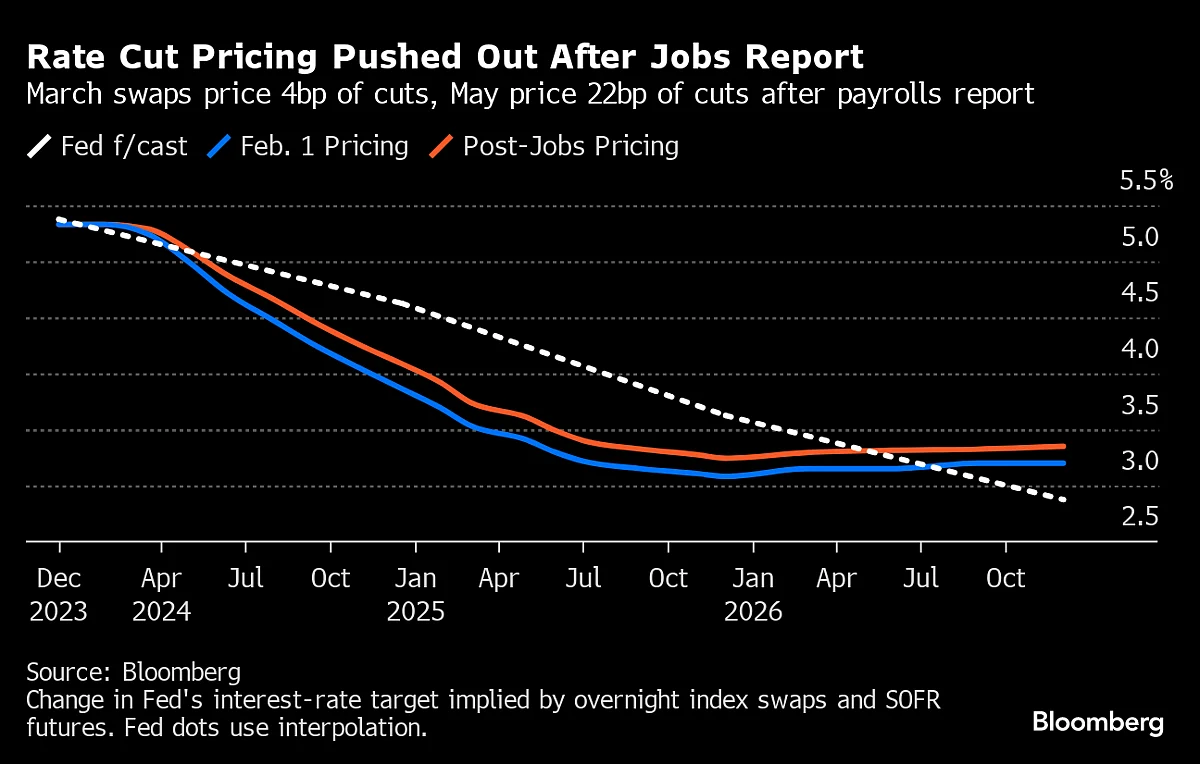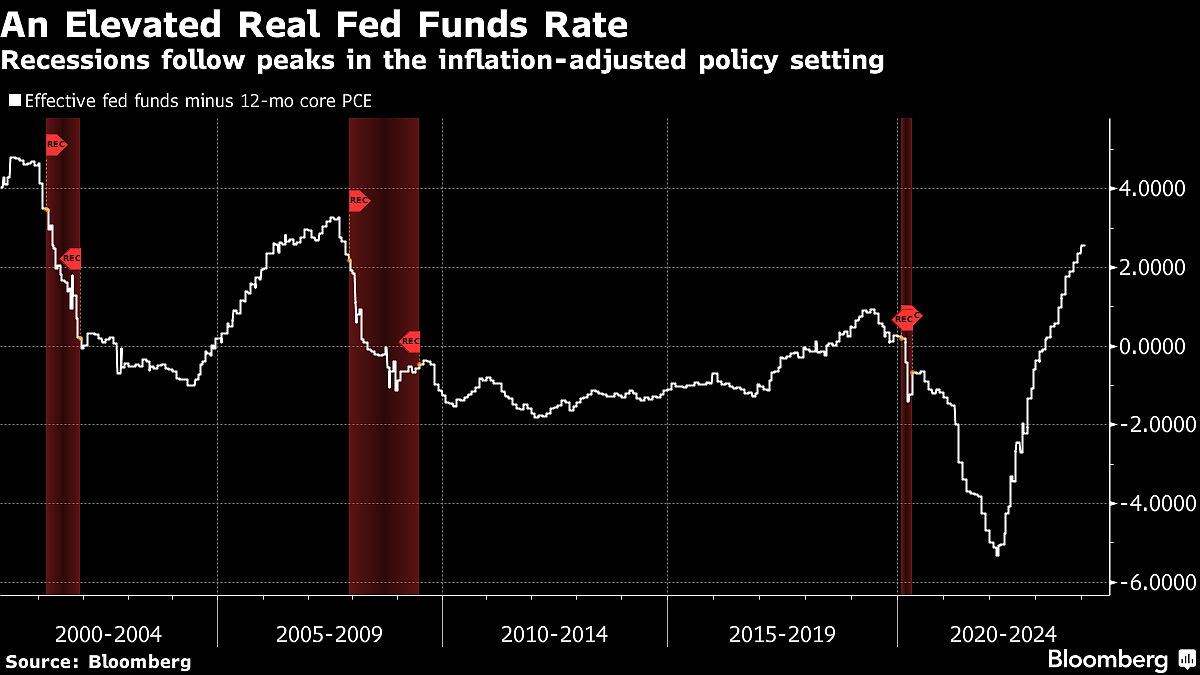Bond Market Rate-Cut Bets Rattled By Powell Pushback, Jobs
The U.S. economy is testing bond traders’ faith that the Federal Reserve will deliver a series of interest-rate cuts this year.

(Bloomberg) -- The US economy is testing bond traders’ faith that the Federal Reserve will deliver a series of interest-rate cuts this year.
The unexpected surge in hiring in January showed there’s little pressure on the central bank to start easing monetary policy just yet, giving it time to see if inflation is headed sustainably toward its 2% target.
Fed Chair Jerome Powell reiterated such a wait-and-see approach from last week — which drove traders to slash bets on a first rate cut before May — in an interview on CBS’s 60 Minutes Sunday evening.
The “danger of moving too soon is that the job’s not quite done, and that the really good readings we’ve had for the last six months somehow turn out not to be a true indicator of where inflation’s heading,” Powell said in the interview.
But Powell left little doubt that the central bank will start loosening this year as the post-pandemic inflation surge subsides. That’s left bond traders convinced rates are coming down at some point — even as questions mount about how far the central bank will go.
“The Fed can deliver three to four rate cuts as the rate of inflation keeps coming down,” said Kevin Flanagan, head of fixed income strategy at Wisdom Tree Investments. But he said the jump in job growth and wages in January do “challenge the Treasury market’s narrative that the labor market is going to soften to the point where you’re going to have aggressive Fed easing.”
Read more: Powell Says Fed Likely to Wait Beyond March to Cut

For Priya Misra, portfolio manager at J.P. Morgan Asset Management, the uncertainty about the Fed’s timing has increased the appeal of five-year notes, which she sees as likely benefiting from a longer rate-cutting campaign.
“The later the Fed begins the process of normalization, the more it will likely have to do due to lags,” she said.
The economy has consistently defied fears that the Fed’s rate hikes — which stopped in July — would set off a recession. Instead, it has continued to expand at a solid pace, and employers added 353,000 jobs to their payrolls in January, the biggest monthly jump in a year and nearly twice what economists expected.
The figures unleashed a fresh selloff in the bond market Friday, pushing up yields across the board. Those on two-year Treasuries jumped as much as 20 basis points to over 4.4%, the biggest one-day spike since March.
Treasuries slid at the open in Asia as Powell’s comments underscored the likelihood that bond investors had overshot in pricing for rapid rate cuts. Treasuries fell, with benchmark 10-year yields climbing four basis points to 4.06% as of 8:04 a.m. in Hong Kong. The greenback held gains over all Group-of-10 peers with Bloomberg Dollar Spot Index rising as much as 0.2%.
What Bloomberg’s Stategists Say...
“The panopoly of labor market figures in January were super strong. Needless to say, this is bearish the bond market and 2024 Fed pricing, at least in the first half of the year.”
— Cameron Crise, MLIV macro strategist
Click here to read more
Yet the still-widespread conviction that the Fed will start easing policy by mid-year is setting a sort of floor under the bond market. Whenever yields spike, buyers have tended to flood back in, seeking to lock in the relatively high payouts before they disappear.
Moreover, there’s a record $6 trillion stashed in money-market funds, which may start to be shifted toward bonds once short-term rates start coming down.
While the current strength of the economy has meant there is little urgency, policymakers are mindful of the risk of keeping interest rates too high for too long. The rate is now in a band of 5.25% to 5.5%, more than twice the level that’s seen as neutral to growth. As inflation comes down, that leaves plenty of room to make policy less restrictive.

Powell on Wednesday said that the central bank is “in a risk management mode” before changing course. Moreover, he said officials welcome a strong labor market as long as inflation continues to recede.
Read More: Goldman, BofA Throw in the Towel on March Rate Cut From Fed
That messaging is a reason why the futures market continues to price in about five quarter-point cuts this year and still put some odds on a first move in March, even after Powell said that was unlikely.
So there may be room for bonds to rally. Bruno Braizinha, rates strategist at Bank of America Corp., advised investors to prepare for the risk that 10-year Treasury yields — now just over 4% — could fall to 3% this year.
“If the market begins to bring down their pricing of the Fed’s neutral policy rate that could pull yields lower,” he said. “Also, there still remains risk for a shock to the economy that will result in the market’s current expectation for a soft-landing not happening. Additionally, inflation may begin to fall more aggressively.”
What to Watch
- Economic data:
- Feb. 5: S&P Global US Services PMI; ISM services index; Senior loan officer survey
- Feb. 7: MBA mortgage applications; trade balance; consumer credit
- Feb. 8: Initial jobless claims; wholesale trade sales and inventories
- Fed calendar:
- Feb. 5: Atlanta Fed President Raphael Bostic
- Feb. 6: Cleveland Fed President Loretta Mester; Minneapolis Fed President Neel Kashkari; Boston Fed President Susan Collins; Philadelphia Fed President Patrick Harker
- Feb. 7: Federal Reserve Governor Adriana Kugler; Richmond Fed President Tom Barkin; Fed Governor Michelle Bowman; Collins
- Feb. 8: Barkin
- Feb. 9: Dallas Fed President Lorie Logan
- Auction calendar:
- Feb. 5: 13-, 26-week bills
- Feb. 6: 42-day cash management bills; three-year notes
- Feb. 7: 17-week bills; 10-year notes
- Feb. 8: 4-, 8-week bills; 30-year bonds
--With assistance from Garfield Reynolds and Michael G. Wilson.
(Updates with Powell’s comments on CBS interview in third and fourth paragraph. Adds Treasuries, dollar index prices in 11th paragraph.)
More stories like this are available on bloomberg.com
©2024 Bloomberg L.P.